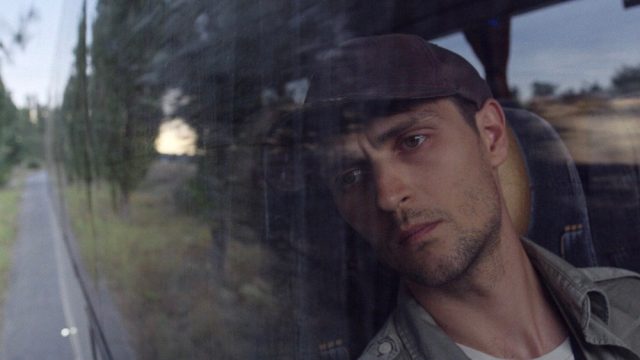In the grasslands of Southern Ukraine, between Crimea and mainland Ukraine, a natural history researcher named Yura (Dmytro Bahnenko) is hoping to track down and photograph a groundhog. If he succeeds, the land can be protected as a European reserve. This apparently simple premise — the kernel at the outset of “The Editorial Office” — can’t begin to hint at the rugged tapestry of thematic and topical threads that Roman Bondarchuk’s second narrative feature proceeds to weave together, the unique product of both the director’s vision and ambition, and also of the circumstances under which it gestated.
Set and shot just before the Russian invasion of Ukraine, and completed during the war, the film closes with a dedication to editor Viktor Onysko, who lost his life in the conflict during a combat mission (his job was completed by Nikon Romanchenko, with contributions from Heike Parplies, who also worked with Bondarchuk on his 2018 debut, “Volcano”).
While attempting to track his groundhog target, Yura catches some arsonists on camera as they set a forest fire. Such a journalistic scoop ought to be an open-and-shut case: publish, expose, let the authorities take action. Unfortunately, life in the Ukrainian provinces doesn’t work that way. As Yura attempts to interest various people in the story, most of them respond with a version of one editor’s blunt assessment that “no-one gives a shit about facts,” and a broader picture begins to unfold of a civilization collapsing into absurdity.
Corrupt politicians learn fashionable dances and attempt to go viral. A violent but wealthy man keeps his girlfriend chained by the ankle on a swimming pool float; she is liberated, then returns to him. Yura’s mother, an unemployed 50-year-old tourism manager enamored by the get-rich-quick promises of an American snake oil salesman, ploughs money she doesn’t have into cryptocurrency. There are hints of cult activity culminating in a sequence that wouldn’t look out of place cut into an Ari Aster movie.
Richard Bach’s “Jonathan Livingstone Seagull” pops up throughout as a reference, and it’s easy to see how that wildly successful allegorical novella applies here: Yura is Jonathan, the seagull that lives to fly, while the rest of his kind are petty and small-minded, surviving rather than living. As the paper’s editor (and Yura’s new boss) puts it, “People won’t think about the war until they see the Moscow tanks rolling in. They want to eat, drink, fuck, pray.” Yura is told that if he wants to succeed as a journalist, he needs to prioritize fabricated human-interest stories (ideally with a morbid or sexual element) and money-spinners (for example, fraudulent political puff pieces hyping the installation of a nonexistent pipeline).
The film may come as a surprise to consumers of Western media, accustomed to seeing Ukraine presented in relatively straightforward terms as the plucky underdog resisting the might of Moscow. Bondarchuk has written neither a love letter to Ukraine nor a full-on indictment. Rather, it’s perhaps best viewed as a complicated elegy for the country’s potential, a surrealist expression of mourning for an endangered worldview based on faith in the value of truth.
While the events depicted in the film often have a larger-than-life feel to them, an effect amplified by their cumulative impact, they are not flights of fancy plucked from the ether, but bear plausible relationships to past, present and future events, as you might expect from someone with Bondarchuk’s documentary background. At one point, a political rival is shot and Yura finds himself taking photographs of the bullet wound in the man’s forehead, to disprove the official line that he has died of COVID.
The film’s critique isn’t targeted at a particular government, but leveled at anyone who collaborates in disrupting the idea that truth matters. Yura’s mother talks at one point about how “people of his kind are neither good nor bad. They’re different. More complicated.” So in a post-truth world, we’re also post-morality. But where George Orwell’s “1984” saw the Party insist that “two plus two equals five” if they said so, the nightmare here is not that one single authority dictates truth, but that anybody can do so, resulting in a fracturing of reality into infinite competing narratives. In Yura’s world, if a lie is proven to be a lie, firstly, no one cares, and secondly, there will be 1,000 more lies ready and waiting to drown out the truth. Part of the appeal of conspiracy theories is that they suggest that at least somebody knows what’s going on. Here, the villain is entropy.
The choice of a groundhog as a motif feels apt, since the little rodent is primarily associated in pop culture with repetition to the point of madness, thanks to the Bill Murray comedy. “The Editorial Office” captures the feeling of being trapped in an absurdist cycle of corruption, where there is no possibility of a satisfying cathartic moment of victory, merely an endless struggle in which all sense of meaning has been eroded. There can be no heroes in such a battle, Bondarchuk is bold enough to suggest, because the battleground itself is such a shape-shifting swamp.






















